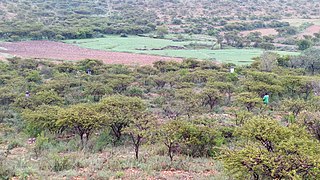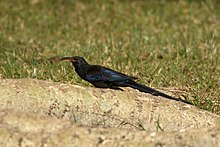
The green wood hoopoe is a large, up to 44 cm (17 in) long, near-passerine tropical bird native to Africa. It is a member of the family Phoeniculidae, the wood hoopoes, and was formerly known as the red-billed wood hoopoe.

The Abyssinian roller, or Senegal roller, is a member of the roller family of birds which breeds across tropical Africa in a belt south of the Sahara, known as the Sahel. It is resident in the southern part of its range, but northern breeding populations are short-distance migrants, moving further south after the wet season.

Bucerotiformes is an order of birds that contains the hornbills, ground hornbills, hoopoes and wood hoopoes. These birds were previously classified as members of Coraciiformes. The clade is distributed in Africa, Asia, Europe and Melanesia.

Erckel's spurfowl, also known as Erckel's francolin, is a species of game bird in the family Phasianidae.

The wattled ibis is a species of bird in the family Threskiornithidae. It is endemic to the Ethiopian highlands and is found only in Ethiopia and Eritrea.

The dusky turtle dove is a species of bird in the family Columbidae. It is found in Burundi, Democratic Republic of the Congo, Eritrea, Ethiopia, Kenya, Malawi, Rwanda, Saudi Arabia, Somalia, South Sudan, Tanzania, Uganda, Yemen, and Zambia.

The white-headed wood hoopoe is a species of bird in the family Phoeniculidae.

The violet wood hoopoe is a species of bird in the family Phoeniculidae. It is found in Angola, Kenya, Namibia, and Tanzania. It looks similar to the black-billed wood hoopoe but with a red beak and a green throat.

The grey-headed batis is a species of bird in the wattle-eyes family, Platysteiridae, it was previously classified with the Old World flycatchers in the family Muscicapidae. It is found in eastern and central Africa.

Rüppell's robin-chat is a species of bird in the family Muscicapidae, that is native to the Afrotropics. It is named for the German naturalist Eduard Rüppell.

The little rock thrush is a passerine bird in the family Muscicapidae. It is found in Eritrea, Ethiopia, Kenya, Oman, Saudi Arabia, Somalia, South Sudan, Tanzania, Uganda, and Yemen. It is found in rocky areas with some trees, and sometimes near settlements. At 15 to 16 centimetres this is the smallest of the Muscicapidae. The male has the head, throat and upper mantle blue-grey, the underparts orange-red, except for the center blackish center tail and tips which form an inverted T shape. The female is duller and paler. It is readily mistaken for a redstart because of its habit of trembling its tail.

The Tacazze sunbird is a species of bird in the family Nectariniidae. It is found in Eritrea, Ethiopia, Kenya, South Sudan, Tanzania, and Uganda.

The baglafecht weaver is a species of weaver bird from the family Ploceidae which is found in eastern and central Africa. There are several disjunct populations with distinguishable plumage patterns. Only some races display a discrete non-breeding plumage.

Heuglin's white-eye, also known as the Ethiopian white-eye, is a species of bird in the family Zosteropidae. It is found in north-eastern and eastern Africa, primarily in Ethiopia and Kenya. Its natural habitats range from subtropical or tropical moist montane forests, to subtropical or tropical high-altitude shrubland, plantations, and rural gardens.

The Abyssinian woodpecker, also known as the golden-backed woodpecker or the golden-mantled woodpecker, is a species of bird in the woodpecker family, Picidae. It is native to Africa, where it occurs in Eritrea and Ethiopia. It appears to be a close relative of the cardinal woodpecker Dendropicos fuscescens.

The black-billed barbet is a species of bird in the Lybiidae family. It is found in Cameroon, Democratic Republic of the Congo, Eritrea, Ethiopia, Kenya, Sudan, Tanzania, and Uganda.

The bearded woodpecker is a species of bird in the family Picidae. It has a distinctive black and white head and brownish barred body. It is native to tropical central Africa. It has an extremely wide range and is a fairly common species, and the International Union for Conservation of Nature has rated its conservation status as being of "least concern". Some taxonomic authorities place this species in Dendropicos.

Addilal is an exclosure located in the Dogu'a Tembien woreda of the Tigray Region in Ethiopia. The area has been protected since 1992 by the local community.

Sesemat is an exclosure located in the Dogu'a Tembien woreda of the Tigray Region in Ethiopia. The area has been protected since 1993 by the local community.

Tukhul is an exclosure located in between the villages of Tukhul and Miheni in the Dogu'a Tembien woreda of the Tigray Region in Ethiopia. The area has been protected since 1998 by the local community.





















